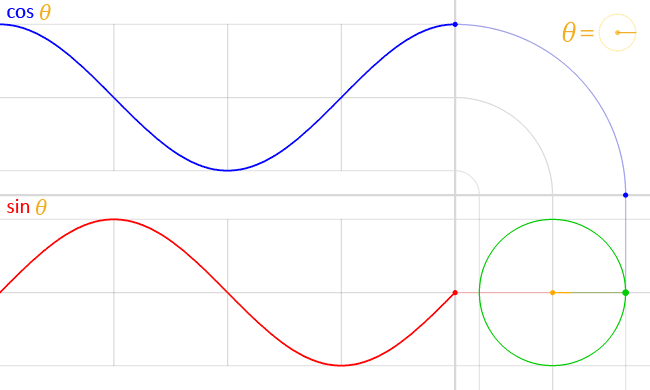A-level Mathematics/CIE/Pure Mathematics 1/Trigonometry
The Trigonometric Functions
[edit | edit source]
Sine
[edit | edit source]The sine of an angle is defined as the ratio between the opposite and the hypotenuse. For a given angle, this ratio will always be the same, even if the triangle is scaled up or down.
Cosine
[edit | edit source]The cosine of an angle is defined as the ratio between the adjacent and the hypotenuse.
Tangent
[edit | edit source]The tangent of an angle is defined as the ratio between the opposite and the adjacent.
The Unit Circle
[edit | edit source]The unit circle is a circle of radius 1. It can be used to provide an alternate way of looking at trigonometric functions.
In the unit circle, a right-angled triangle can be drawn with the radius as its hypotenuse. Thus, the hypotenuse is 1 and the sine and cosine functions refer to the coordinates of a point on the unit circle.

Graphing Trigonometric Functions
[edit | edit source]
A sine graph starts at , then oscillates with a period of and an amplitude of .

A cosine graph is like a sine graph in that it oscillates with a period of and an amplitude of , but it starts at

A tangent graph starts at , goes to infinity as it approaches , emerges from negative infinity after , then repeats this at . The tangent graph has a period of .
Exact Values
[edit | edit source]It is useful to know the following exact values of trigonometric functions:
| x/° | x/rad | sin x | cos x | tan x |
|---|---|---|---|---|
| 0 | 0 | 0 | 1 | 0 |
| 30 | π/6 | 1/2 | √3/2 | 1/√3 |
| 45 | π/4 | 1/√2 | 1/√2 | 1 |
| 60 | π/3 | √3/2 | 1/2 | √3 |
| 90 | π/2 | 1 | 0 | undefined |
Inverse Trigonometric Functions
[edit | edit source]Some sources may use , , and to represent the inverse trigonometric functions, but this notation is not endorsed by Cambridge International
The inverse trigonometric functions are functions that reverse the trigonometric functions, just like any other inverse function. The inverse trigonometric functions are: , which is the inverse of ; , which is the inverse of ; and , which is the inverse of .
Trigonometric Identities
[edit | edit source]An identity is a statement that is always true, such as . A trigonometric identity, therefore, is a trigonometric statement that is always true.
It is helpful to know the following identities:
These identities can be used to prove other identities.
e.g. Prove that
Solving Trigonometric Equations
[edit | edit source]When solving a trigonometric equation, it is important to keep the interval in mind.
e.g. Solve for .





























